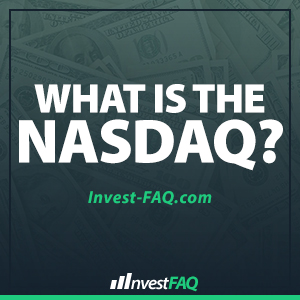 NASDAQ is an abbreviation for the National Association of Securities Dealers Automated Quotation system. It is also commonly, and confusingly, called the OTC market.
NASDAQ is an abbreviation for the National Association of Securities Dealers Automated Quotation system. It is also commonly, and confusingly, called the OTC market.
The NASDAQ market is an interdealer market represented by over 600 securities dealers trading more than 15,000 different issues. These dealers are called market makers (MMs). Unlike the New York Stock Exchange (NYSE), the NASDAQ market does not operate as an auction market (see the FAQ article on the NYSE). Instead, market makers are expected to compete against each other to post the best quotes (best bid/ask prices).
A NASDAQ level II quote shows all the bid offers, ask offers, size of each offer (size of the market), and the market makers making the offers in real time. These quotes are available from the Nasdaq Quotation Dissemination Service (NQDS). The size of the market is simply the number of shares the market maker is prepared to fill at that price. Since about 1985 the average person has had access to level II quotes by way of the Small Order Execution System (SOES) of the NASDAQ. Non-professional users can get level II quotes for a monthly fee.
SOES was implemented by NASDAQ in 1985. Following the 1987 market crash, all market makers were required to use SOES. This system is intended to help the small investor (hence the name) have his or her transactions executed without allowing market makers to take advantage of said small investor. You may see mention of “SOES Bandits” which is slang for people who day-trade stocks on the NASDAQ using the SOES. A SOES bandit tries to scalp profits on the spreads.
A firm can become a market maker (MM) on NASDAQ by applying. The requirements are relatively small, including certain capital requirements, electronic interfaces, and a willingness to make a two-sided market. You must be there every day. If you don’t post continuous bids and offers every day you can be penalized and not allowed to make a market for a month. The best way to become a MM is to go to work for a firm that is a MM. MMs are regulated by the NASD which is overseen by the SEC.
The brokerage firm can handle customer orders either as a broker or as a dealer/principal. When the brokerage acts as a broker, it simply arranges the trade between buyer and seller, and charges a commission for its services. When the brokerage acts as a dealer/principal, it’s either buying or selling from its own account (to or from the customer), or acting as a market maker. The customer is charged either a mark-up or a mark-down, depending on whether they are buying or selling. The brokerage can never charge both a mark-up (or mark-down) and a commission. Whether acting as a broker or as a dealer/principal, the brokerage is required to disclose its role in the transaction. However dealers/principals are not necessarily required to disclose the amount of the mark-up or mark-down, although most do this automatically on the confirmation as a matter of policy. Despite its role in the transaction, the firm must be able to display that it made every effort to obtain the best posted price. Whenever there is a question about the execution price of a trade, it is usually best to ask the firm to produce a Time and Sales report, which will allow the customer to compare all execution prices with their own.
In the OTC, the public almost always meets dealer, which means it is nearly impossible to buy on the bid or sell on the ask. The dealers can buy on the bid even though the public is bidding. Despite the requirement of making a market, in the case of MM’s there is no one firm who has to take the responsibility if trading is not fair or orderly. During the crash of 1987 the NYSE performed much better than NASDAQ. This was in spite of the fact that some stocks have 30+ MMs. Many OTC firms simply stopped making markets or answering phones until the dust settled.
Academic research has shown that an auction market such as the NYSE results in better trades (in tighter ranges, less volatility, less difference in price between trades). When you compare the multiple market makers on the NASDAQ with the few specialists on the NYSE (see the NYSE article), this is a counterintuitive result. But it is true.
In 1996 the NASDAQ was investigated for various practices. It settled a suit brought against it by the SEC and agreed to change key aspects of how it does business. Forbes ran a highly critical article entitled “Fun and Games” on the NASDAQ. This was once available on the web, but has vanished.
Related topics include price improvement, bid and ask, order routing, and the 1996 settlement between the SEC and the NASDAQ. Please see the articles elsewhere in this FAQ about those topics.
In 1998, a merger between the NASD and the AMEX resulted in the Nasdaq-Amex Market Group.
For more information, visit their home page: http://www.nasdaq.com
Article Credits:
Contributed-By: Bill Rini, Jeffrey Benton, Chris Lott
